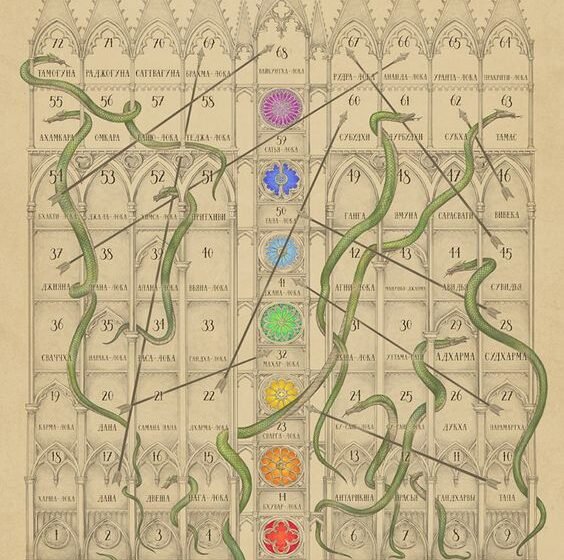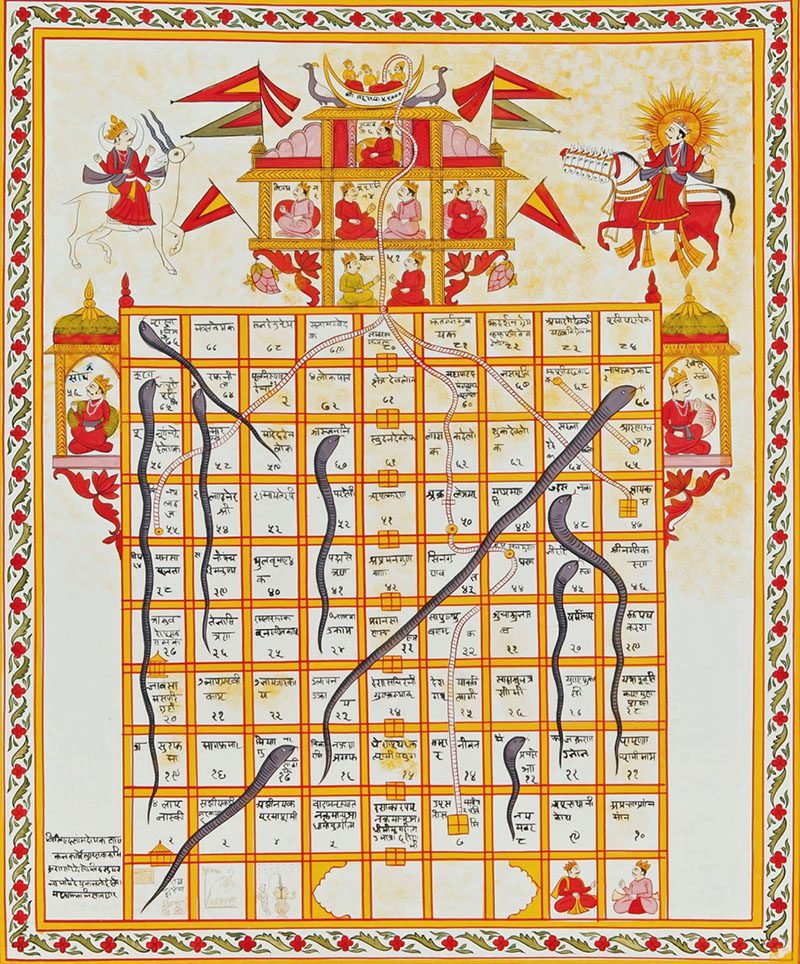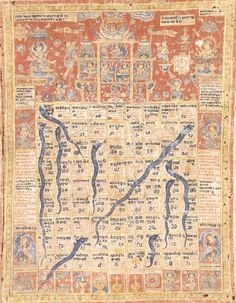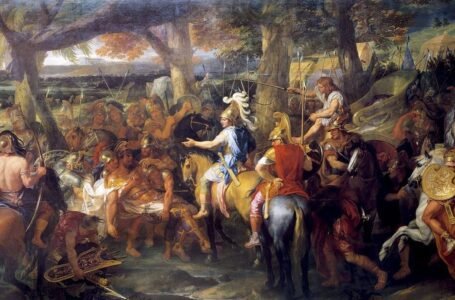Moksha Patam: The Ancient Game of Snakes and Ladders with a Spiritual Twist

If I were to ask you which was the first board game you owned, most of you would say Snakes and ladders (Saanp-Sidhi). However, we are not aware of the origin, journey and the deep ingrained meaning of this wonderful game. Well not anymore!

The game of Snakes and Ladders is a board game that is a worldwide classic. The game originated in ancient India and was known as “Moksha Patam”. It is based on morality called Vaikunthapaali or ‘The ladder to salvation’. The game was also known as Moksha Patamu, the earliest known Jain version dating back to 16th century. Another name of the game was “Leela”- and represented the concept of consciousness in Hinduism.
In Tamil Nadu, the game is called Parama padam and is often played by devotees of Vishnu during the Vaikuntha Ekadashi festival in order to stay awake during the night. Hindu spiritual instructors used Moksha Patam to teach children about the consequences of good and evil. The ladders signified virtue, while the snakes represented depravity. The game’s moral was that good deeds lead to salvation (Moksha), whereas evil actions result in rebirth in lower forms of life (Patamu).

The number of ladders was smaller than the number of snakes, symbolizing the difficulty of choosing the right route over the easy path to death and misery. The numbered squares also had significance as ‘100’ represented Salvation.
The Squares of virtue on the original game are Faith (12), Reliability (51), Generosity (57), Knowledge (76), Ascetism (78); while the squares of evil are Disobedience (41), Vanity (44), Vulgarity (49), Theft (52), Lying (58), Drunkenness (62), Debt (69), Murder (73), Rage (84), Greed (92), Pride (95), and the most hated Lust (99).

The game’s religious and moral themes are evident. Lust is the final enemy. The lust is not necessarily sexual, but has a similar intensity. It is the desire to take possession of things that are not yours. Envy might hinder one’s path to redemption.
The game is about life; thus, it has an ongoing attraction. It appeals to our need for salvation and freedom from adversity. Educators can use this tool to address moral dilemmas that children confront as they grow.
The game’s basic concepts inspired a version that appeared in Victorian England in 1892. The game has also been understood and utilized to teach about the consequences of good versus bad behaviour. The board was covered in symbolic imagery from ancient India, with gods, angels, and majestic beings at the top and animals, flowers, and humans throughout.

In an attempt to better align the game with Victorian moral doctrines, English virtues and vices were introduced in place of Indian ones when the game was brought to England. Ladders of Thrift, Penitence, and Industry led to the squares of Fulfilment, Grace, and Success; snakes of Indulgence, Disobedience, and Indolence led to illness, shame, and poverty. The English version of the game was more forgiving because it had equal amounts of both snakes and ladders, whereas the Indian version had more snakes than ladders.
Another version of the game popular in Muslim world is known as “Shatranj al’-urafa” with variations found in India, Iran and Turkey. In this version, based on Sufi philosophy, the game depicts the dervish’s desire to abandon the trappings of worldly life and reach unity with God.

After its popularity in the UK, it was introduced in the USA in 1940s by the name Chutes and Ladders. The snakes were replaced by children descending by Chutes and climbing ladders, in a playground setting. In the Canadian version, Snakes are replaced by toboggan (ice-boats), while in South Africa the Snakes and ladders were sold printed behind egg boxes. However different the version, the basic principle of the game remained the same.
We are all aware of the game rules are principles. The popular home rule, “At the start of the game, each player is required to throw a one on their turn in order to begin moving forward,” is found in many contemporary Indian households. This could be a reference to the old saying that “every journey begins with a single step.” Coincidentally, the famous proverb “back to square one” can also be traced back or lest, influenced by the game of snakes and ladders where if one commits a blunder, he returns to the square one.

With its lengthy history and cultural significance, Moksha Patam has gained recognition across India and beyond. Moksha Patam’s popularity is a testament to its capacity to foster wellbeing and spiritual connection, from its modest beginnings as a spiritual practice to its modern evolution into a global phenomenon. This distinctive custom will undoubtedly enthral audiences worldwide for many years to come as it develops further.


